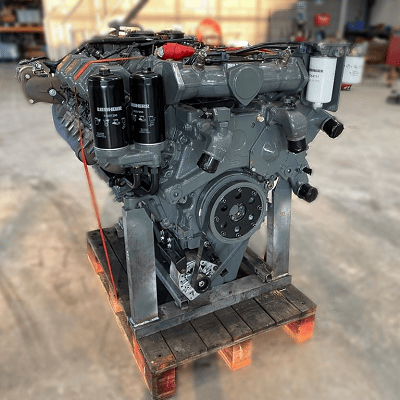The process of a dyno test on a Liebherr engine

When it comes to heavy machinery, reliability and power are paramount. Liebherr, a name synonymous with innovation and excellence in engineering, stands tall as a pioneer in the realm of heavy equipment and machinery. From towering cranes to robust excavators, Liebherr’s engineering prowess extends to the heart of these machines. We delve into the world of dyno testing a Liebherr engine, uncovering the meticulous process behind unleashing the raw power concealed within.
The foundation of excellence
Before we embark on the journey of dyno testing, it’s crucial to understand the foundation upon which Liebherr engines are built. With decades of engineering expertise and commitment to quality, Liebherr engines are crafted to withstand the most demanding environment and deliver unparalleled performance. Each component is meticulously designed and rigorously tested to ensure reliability, efficiency and longevity.
The process
1 Preparation: The engine undergoes meticulous preparation before being mounted onto the dynamo meter. This includes ensuring all connections are secure, fluids are filled to the appropriate levels, and sensors are properly calibrated.
2 Mounting: The engine is carefully mounted onto the dynamometer, a specialized device designed to simulate real-world operating conditions. Precision is paramount during this step to ensure accurate results.
3 Initial checks: Once mounted, a series of initial checks are conducted to verify proper alignment, connection integrity, and functionality of all engine systems.
4 Warm-up: The engine is started and allowed to warm up to operating temperature. This ensures consistent results and minimizes the risk of damage during testing.
5 Baseline testing: With the engine warmed up , baseline tests are conducted to establish initial performance metrics. This includes measuring power output, torque, fuel consumption, and emissions at various RPM levels.
6 Load testing: The engine is subjected to progressively increasing loads to simulate different operating conditions, such as idle, partial load and full load. This allows engineers to assess performance across the entire operating range and identify any potential issues or optimization.
7 Data analysis: Throughout the testing process, data is continuously collected and analyzed in real-time. Advanced instrumentation and software are used to monitor performance metrics and identify trends or anomalies.
8 Optimazation: Based on the data analysis, adjustments may be made to optimize engine performance. This could involve fine-tuning fuel injection timing, adjusting air-fuel ratios, or optimize turbocharger boost pressure.
9 Validation: Once testing is complete, the results are meticulously reviewed and validated against predetermined criteria and specifications. Any deviations or anomalies are thoroughly investigated to ensure accuracy and reliability.
10 Reporting: Finally, a comprehensive report is generated detailing the results of the dyno testing, including performance metrics, observations, and any recommendations for further optimization or refinement.
The outcome of dyno testing
Dyno testing a Liebherr engine is more than just a routine procedure – it’s a testament to the unwavering commitment to excellence that defines Liebherr’s engineering philosophy. By subjecting their engines to rigorous testing and analysis, Liebherr ensures that each engine delivers the uncompromising performance, reliability, and efficiency that customers expect.
In conclusion, dyno testing a Liebherr engine is not just about measuring power output. It’s about unlocking the true potential of these remarkable engines and ensuring they exceed expectations in the most challenging environments imaginable.
Pup Joints are used to adjust the height of full length TUBING or CASING strings. They are also used to adjust the depth of downhole tools.
EASTSUN can customize any length of the pup joint as our customer required. we could offer the sample for free charge but do not pay the cost of freight.
With the subsidiaries of Wuxi Eastsun Trade Co. Ltd and Taizhou Guangfung Oil EquIpment Manufactoty. Established from 2003 Esastsun always focus on OCTG products. The main products of EASTSUN are API 5CT tubing casing pup joint coupling nipple crossover geological drill pipe and line pipe as well as their materials which with different kinds of steel grades and threads.
Our annual production stands at 3,0000 metric tons. We follow quality control system of API5CT and API5L strictly to ensure quality. Based on this, our products are exported to clients all over the world. Furthermore, our perfect services, advanced technology, modern equipment and strict management make our products more popular and obtain a good reputation among our clients. As our company's business extension, at the end of 2006, we have also successfully developed the market for hardware and construction machinery, such as bearings and gondola shelving. All these products are qualified after being tested by authentic system. We always carry out enterprise spirit of "taking trust as essential, mutual benefit and making win-win situation". Now we are hoping to develop long-term, business relationships with clients from around the world and we welcome interested companies to contact us with their inquiries. Our qualified staff is standing by to deal with your order.
Pup Joint,Tubing Pup Joint,Pup Joint Adalah,Integral Pup Joint
ESASTSUN OILFIELD EQUIPMENT MANUFACTURING (CAMBODIA) CO., LTD , https://www.eastsuncambodia.com